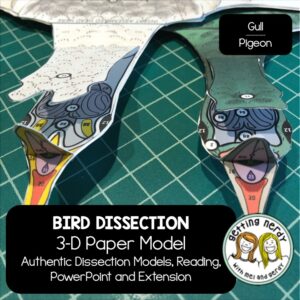
Want to incorporate more outdoor science lessons in your urban classroom but lack the green space to do it? These 15 tips will have you and your kiddos slapping on the sunscreen and your sunglasses and heading into the great outdoors in no time!
- Use what you’ve got: Even in urban areas, schools often have some outdoor space that can be utilized for learning. Rooftops, courtyards, balconies, parking lots or any available open space can be used for observing local wildlife, planting container gardens, viewing the sky…
- Use your community: Do you have local parks around your school? Botanical gardens to study a unit on botany? A zoo to visit during your classification unit? What about a nearby urban farm that might offer outdoor learning opportunities for your students in agriculture? Partner with your community to explore options that may not be available at your school campus.
- Make it virtual: If physical green space on your campus or nearby is scarce, leverage technology to bring outdoor science into your classroom! There are tons of augmented and virtual reality experiences out there – check out one of our partners – Victory XR and VR – for some great opportunities. Search for online nature cams and observe animal behavior in it’s natural, (almost) untouched habitat. Take a virtual field trip with the Nature Conservancy. There are so many options out there.
- Build a Container Garden: Container gardens can be created anywhere with the right soil, light and water requirements. You can add container gardens to your classroom windowsills, in an available parking space, in the road verge (that space between the sidewalk and the road) or in that space between your building and the sidewalk, or your rooftop if you have access to it. Container gardens provide a great opportunity to teach students about plant germination and growth, pollinators, tropisms, micro-ecosystems, micro-biota in the soil, and more.
- How About Vertical Gardens: No room for container gardens? How about growing your plants vertically on school fences or walls, or write a grant or Donor’s Choose request for some indoor gardens like these from Amazon: Countertop Indoor Garden or Wall Planters
- Take a Field Trip: If you can’t do something right around your school, it’s time to travel to the nature. Organize a field trip to a nearby park to do plot samples or observe local wildlife, head out to a nearby nature preserve and listen to a ranger talk, hit the museums for explorations in Earth’s history, or visit an educational center that provides hands-on outdoor experiences. A great place to start is by searching your area’s National Park or State Park website and click on our “Plan Your Visit” to get some ideas.
- Make it Work for You: If traveling isn’t in the cards, you can modify any of the outdoor science activities you want to do to fit in your urban environment. You can conduct surveys using local wildlife. Study the air quality in your area by observing lichens and other plant growth. Examine the effects of pollution on plant and animal life. This is a great opportunity to use our Biome in a Bottle activity!
- Indoor Nature Stations: Similarly to what we said above, you can bring the nature indoors by setting up indoor stations with live plants, aquariums or terrariums with reptiles, amphibians, fish, insects, or arachnids, or by completing nature stations like our water cycle simulation to bring elements of nature into the classroom.
- Do an Urban Wildlife Study: If you can’t explore the nature in other habitats, explore the wildlife that can thrive in your own urban environment! Study pigeon, bat and hawk nesting behaviors – you can even learn about pigeon anatomy with our Pigeon Paper Dissection (and compare it with that of a sea bird, the Gull!). Observe squirrels and how they adapt to living in a virtually treeless area. What insects thrive in urban environments? What adaptations do urban plants have that allow them to grown and thrive in the city?
- Create Your Own Green Roof: Collaborate with your school or community to establish a green roof. Not only does this provide a learning opportunity for students, but it also contributes to sustainable urban development. While you’re up there, consider getting urban beehives and help save the bees. Look at you being interdisciplinary with your lessons!
- Art and Nature: Here’s an opportunity for integrating another discipline into your science classroom, bring art into your outdoor science learning! Encourage students to create nature-inspired artwork using urban materials – turn this into a deeper learning opportunity by having students reduce-reuse-recycle as they create their works of art.
- Go on a Nature Walk: Fresh air is good for your kiddos, and even if you can’t spend a lot of time in an outdoor science classroom or dedicated area. Organize short nature walks around the school grounds and nearby. Have students bring field notebooks and have them focus on observing urban plants, insects, birds, and architectural elements that mimic nature. When you return to the classroom, have them identify what they saw by using field guides and dichotomous keys, or to create their own architectural concepts inspired by what they saw in nature.
- Citizen Science: Have your students become advocates for their environment by engaging them in citizen science projects. Projects that involve collecting data on topics like air quality, noise pollution, or temperature variations in different parts of the urban environment open their eyes to what’s happening around them and invite them to become student activists for change in their area.
- Sustainability Projects: Like our rooftop green space idea above, you can teach students about urban sustainability and the importance of green spaces for a healthier city. Encourage them to brainstorm and execute projects that improve their local environment – it will all be theirs one day, after all.
- Advocate for Change: One thing’s for sure, our students are outspoken and full of passion – let’s use that passion to fight for change. Have students reflect on their outdoor science learning experiences and use them as a platform to advocate for more green spaces and environmental awareness in their urban community.
Be the change you want to see in the world…🤓🤓❤️
✕
Inspire Students. Love Teaching.
We have everything you need to successfully teach life science and biology. Join over 85,000 teachers that are seeing results with our lessons. Subscribe to our newsletter to get a coupon for $5 off your first order!
Want some extra amazingness? Use the coupon NEWNERD to get 15% off your first purchase of a Nerdy resource from our website! We love our Nerdy teachers!


